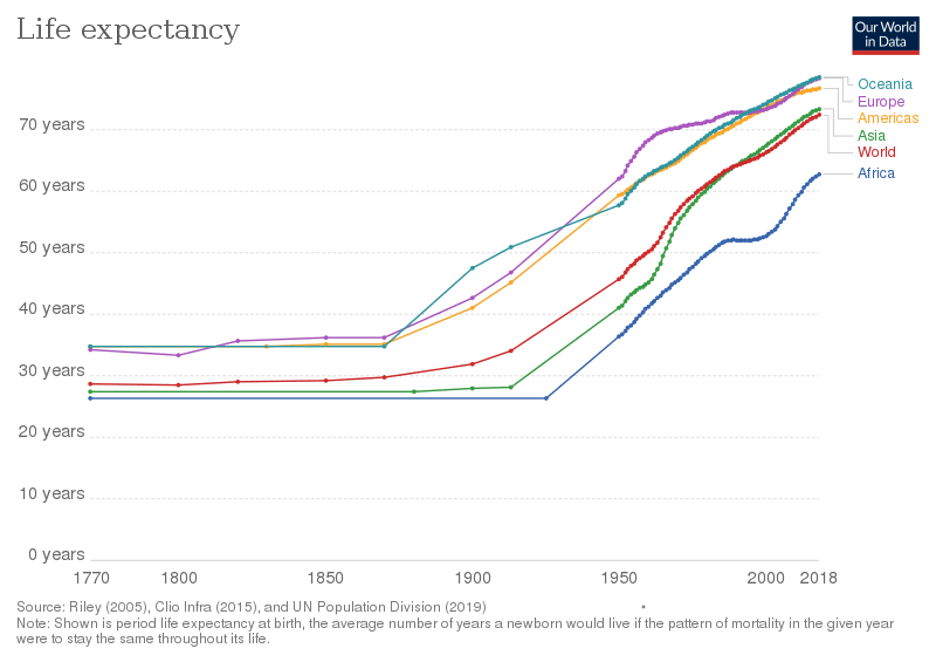Sai Rayasam, Life Sciences, Summer 2020
Figure 1: This graph shows the average life expectancy within the world’s different continents throughout the past 250 years. As it shows, the average life expectancy was relatively low and static until around the 19th century, after which new advances in health, agriculture, industrial production, and more helped humans to live much longer. Since the 1930s, the life expectancy has been increasing within all continents at a relatively steady rate. However, with a recent discovery in the process of aging, that rate might actually increase.
(Source: Wikimedia Commons)
The notion of extending one’s life has been a topic of wonder and fascination for many people throughout the years. Before the 19th century, the average life expectancy had no clear trend. It mostly fluctuated between 30 and 40 years for the whole time period. However, over the last 120 years, the world has achieved impressive progress in health and other fields affecting the standard of living, leading to a significant increase in life expectancy.2 Currently, the average global life expectancy is around 73.2 years.3 All these advancements have been the result of years of research and development, and, on July 17th, a team of researchers at UCSD published a study that pushed our knowledge of human aging (and perhaps our capacity to affect it) even further.1
Our lifespans as humans are dictated by the aging of our individual cells. Over time, they become bigger and less capable of division. Eventually, many cells start to lose their ability to function. To investigate if different cells age at the same rate due to the same causes, the UCSD researchers conducted studies on the budding yeast Saccharomyces cerevisiae (a yeast instrumental in the process of winemaking, baking, and brewing).1,4 They chose this species because it is easy to work with for investigating mechanisms of aging. The researchers discovered that even cells with the same genetic material can actually age in strikingly different ways. Using microfluidics and computer modeling techniques, they found that the cells actually aged in two different ways. Around half of the cells embarked on the “nucleolar path,” where the stability of the nucleolus (a region of the cell nucleus in which ribosomes, the protein-producing ‘factories’ of the cell, are synthesized) gradually declined. The other half embarked on the “mitochondrial path,” where the mitochondria of the cells gradually lost their capacity to synthesize ATP over time. Furthermore, the researchers found that the cells embark on either one of these “aging paths” for the rest of their lives, making it easier to distinguish between them.1
At the heart of both paths, the researchers found a “master circuit” in the DNA of the yeast cells. This master circuit controls which “path” the cells embark on and how they do it, similar to how an electric circuit controls home appliances. Having developed this new model of aging, the researchers found they could manipulate the two “aging paths.” Using computer simulations, the researchers reprogrammed the “master circuit” by modifying its DNA, allowing the creation of a new “aging path” that dramatically increases lifespan. Expanding on this discovery, the researchers aim to test their new model on more complex organisms and eventually onto human cells.1
Sources:
- University of California – San Diego. (2020, July 16). Two paths of aging: New insights on promoting healthspan: Master aging circuit identified. ScienceDaily. Retrieved July 19, 2020 from www.sciencedaily.com/releases/2020/07/200716144732.htm
- Roser, M., Ortiz-Ospina, E., & Ritchie, H. (2020, October). Life Expectancy. Our World in Data. Retrieved July 19, 2020 from https://ourworldindata.org/life-expectancy
- Worldometer. (n.d). Life Expectancy of the World Population. Worldometer. Retrieved July 19, 2020 from https://www.worldometers.info/demographics/life-expectancy/
- Stewart, G.G. (2014). Saccharomyces cerevisiae. ScienceDirect. Retrieved July 19, 2020 from https://www.sciencedirect.com/topics/neuroscience/saccharomyces-cerevisiae
- Li, Y., Jiang, Y., Paxman, J., O’Laughlin, R., Klepin, S., Zhu, Y., Pillus, L., Tsimring, L., Hasty, J., Hao, N. (2020, July 17). A programmable fate decision landscape underlies single-cell aging in yeast. Science. Retrieved July 19, 2020 from https://science.sciencemag.org/content/369/6501/325


Leave a Reply